The 2010 Haiti earthquake airport story is much shorter than the seaports.
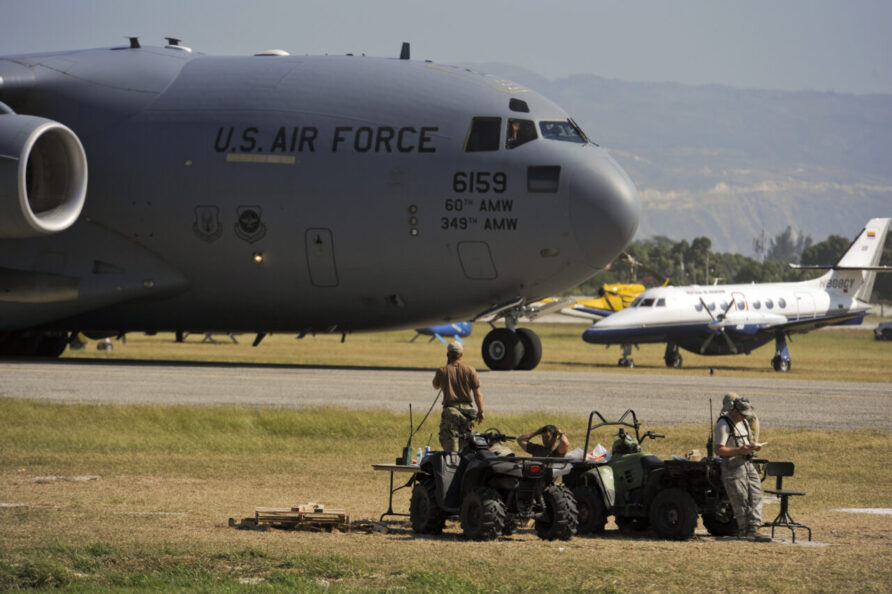
This is for a few reasons. First, the main international airport at Port-au-Prince was relatively unscathed by the earthquake, there were not that many in the country, and finally, the bulk of aid cargo would go by sea due to the massive tonnages required.
Haiti Airports Before and After the Earthquake
Outside of Port-au-Prince, the largest was at Cap-Haïtien.
Other such as those at Hinche, Jérémie, Les Cayes, Port-de-Paix, Anse Rouge, Ouanaminthe, Pignon, and Port Salut were either unpaved or relatively small.
Jacmel would play a larger role than those above but as with the seaport, the centre of gravity was at Port-au-Prince, and for the airport logistics, that meant the Toussaint Louverture International Airport (TLIA)
Whilst the TLIA runway was a generous 3,000m long, other facilities were less well provisioned.
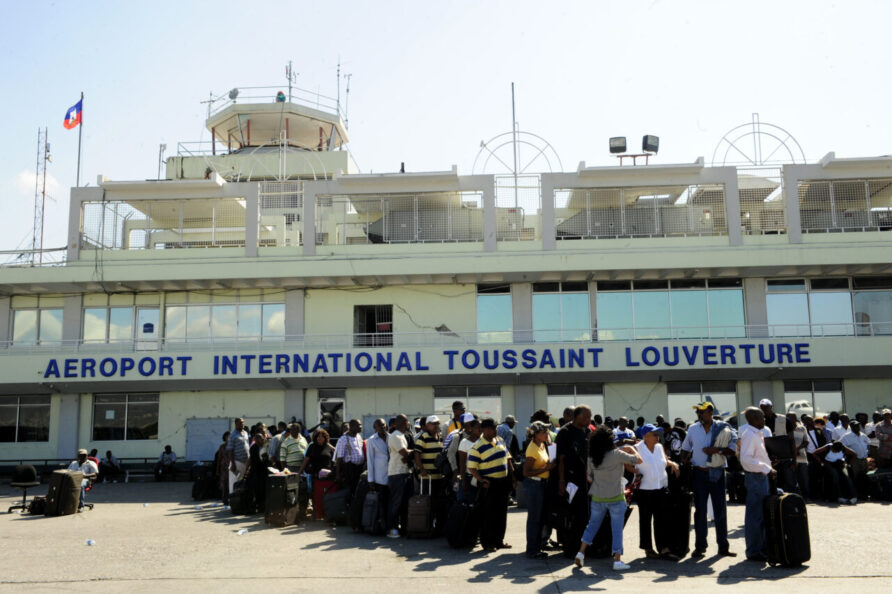
All communications equipment was housed in the control tower, and airport lighting was inoperable due to the lack of power.
Initial Response (12th — 14th of January 2010)
The day after the earthquake on the 13th of January 2010, the US Coastguard reported that the airport at Port-au-Prince was operable, but the control tower was not usable.
AFSOUTH requested Airspace Control Authority and Senior Airfield Authority status on the same day.
Charleston Air Force Base was designated as the primary ‘Airport of Departure’, with Homestead Air Reserve Base as a secondary location.
Initial air traffic control was by those on the US Coastguard Cutter Forward, but only for military and coastguard aircraft.
Alongside, the seaport, Joint Task Force – Port Opening was to ‘safely run aerial port operations and maximize humanitarian assistance throughput’
JTF-PO tasked the 1st Special Operations Wing’s Joint Special Operations Air Component, 15th Special Operations Squadron and 720th Special Tactics Group
Through the early hours of the 13th of January 2010, the 623rd Air Operations Center (AOC) of the US Air Force Special Operations Command (AFSOC) coordinated to establish an initial entry package of 16 aircraft and a Joint Special Operations Air Detachment (JSOAD).
The package included a deployable HQ, air traffic control, airfield operations, medics, and lighting and cargo handling equipment.
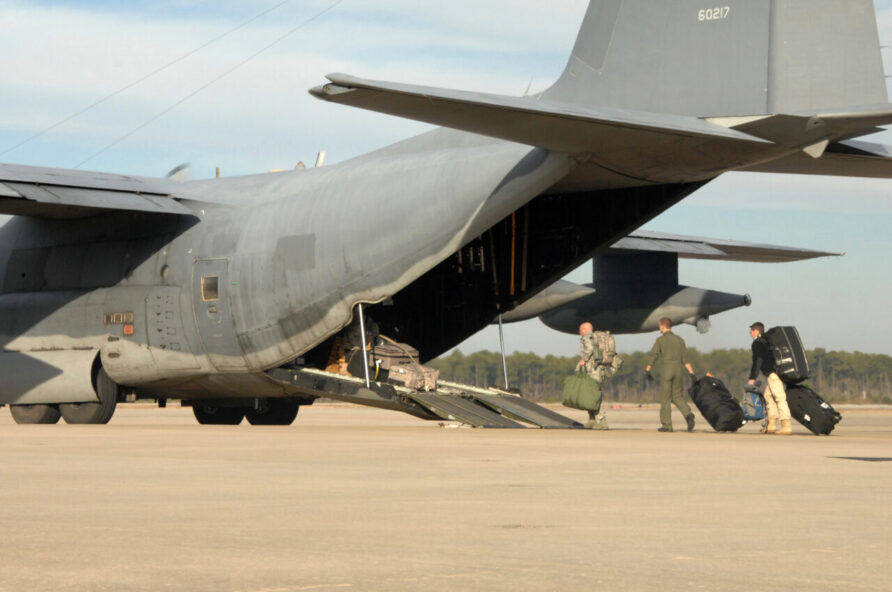
In parallel with AFSOC, Special Operations Command South (SOCSOUTH), headquartered at Homestead Air Reserve Base in Florida, used a DHC-8 aircraft from the 27th Special Operations Wing at Cannon Air Force Base to establish a small situational team awareness team that landed at the airport at 18:00 on the 13th of January 2010, the first US forces to arrive.
The SOCSOUTH team communicated the state of the airport to the by-then inbound MC-130 aircraft (two of them) from AFSOC that would land an hour or so later.
The AFSOC aircraft carried 37 personnel, including the command staff, and medical, weather and air traffic control specialists.
Within 28 minutes of landing, the combat controllers had established airspace management, setting up shop in the open air using a couple of folding tables.
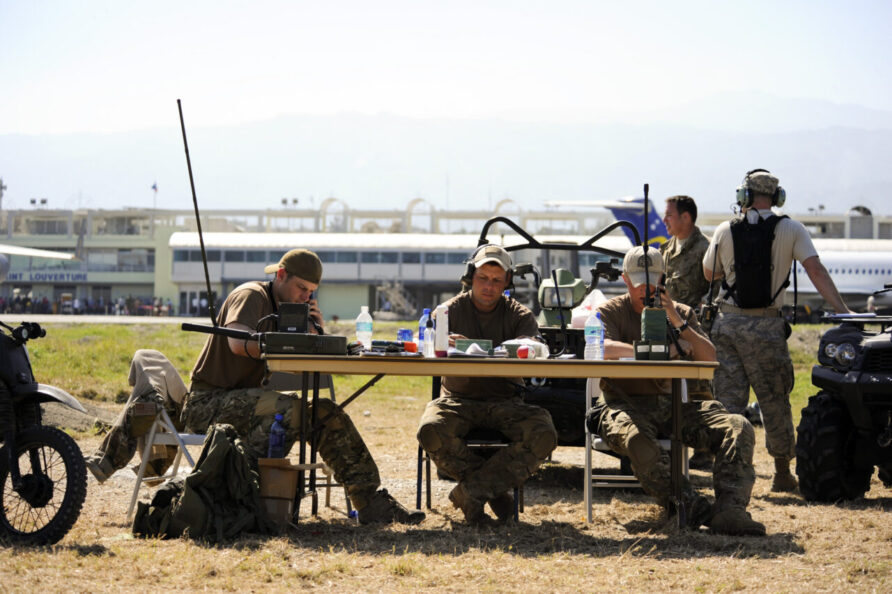
Aircraft were guided to their parking spots using motorcycles and quad ATVs.
First responders had also arrived, search and rescue teams from Iceland, Cuba, and Peru being the first.
The security team started to work on the best methods to secure the aircraft, and the medical and rescue teams also started to get to work.
It was soon realised that they would have to accept some mission scope expansion.
Everything from loading and loading aircraft, passenger handling, security, air traffic management, weather reporting, security, and aircraft ground movement would be on the shoulders of the small AFSOC team.
As aircraft started to stream into Haiti from all over the world, they set about their business.
Many of the early aircraft were from media organisations, consuming valuable space in the airport.
At 14:00 on the 14th of January 2010, a Notice to Airman (NOTAM) was released confirming that aircraft flying to Haiti required a designated slot and only on the ground for one hour before leaving without refuelling.
On the same day, the AFSOC team established relationships with three of the four airport cargo handling companies, the fourth taking exception to them ‘borrowing’ the tug to move the Chinese aircraft!
Additional personnel and equipment arrived and the 817th Contingency Response Group (CRG) was formed, from the 621st Contingency Response Wing of the USAF, a unit specifically tasked with opening and operating airfields for Air Mobility Command.
The first elements of the Air Mobility Command’s Contingency Response Group (CRG) arrived on the evening of the 14th to relieve some AFSOC personnel who had worked flat out.
A Joint Assessment Team (JAT) also arrived on the 14th.
JAT determined that international relief flights were landing faster than they could be unloaded, ramp space was severely limited and getting supplies out of the airport perimeter was hampered by the lack of suitable equipment.
At one point, 44 aircraft were parked at the airport, but only two fuel trucks and two tow trucks/tugs to get them away.
The FAA imposed a ground stop for civilian aircraft that wanted to access the airport to provide space to get aircraft already there to depart. Media reports incorrectly reported that the airport was closed when it was more of a prioritisation exercise, and many aircraft ignored the ground stop anyway.
Capacity (15th January onwards)
US Navy P-3 and USAF Global Hawks and OC-135s provided extremely detailed imagery.
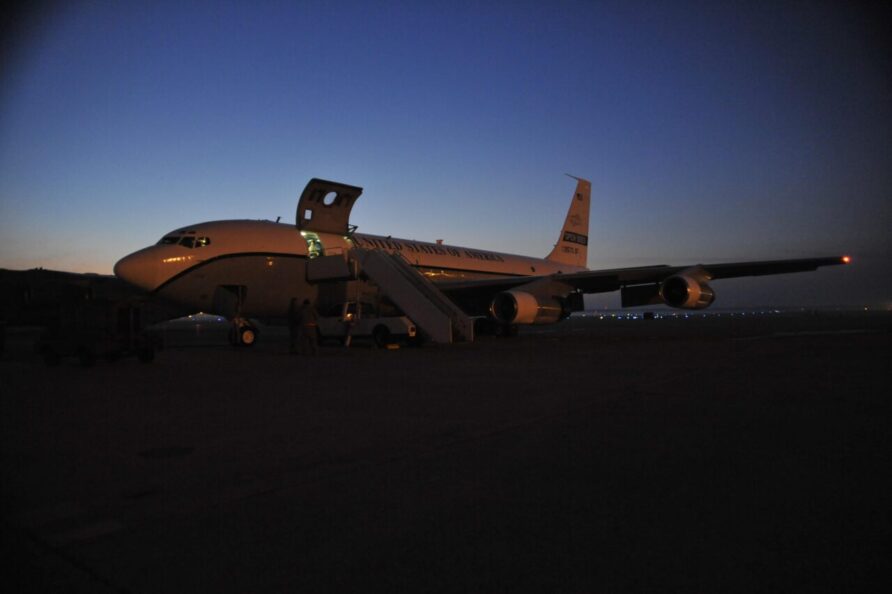
U-2 and Predators also added to the imagery and video available to assess the situation.
Working with Google and other satellite imagery providers, Haiti was, within a few days, one of the most imaged places on Earth.
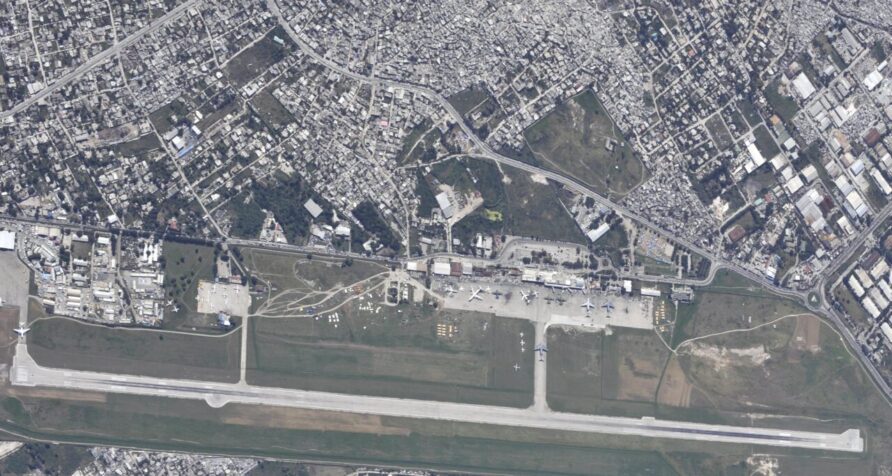
AFSOC and CRG had resolved the initial chaos, but the airport was saturated.
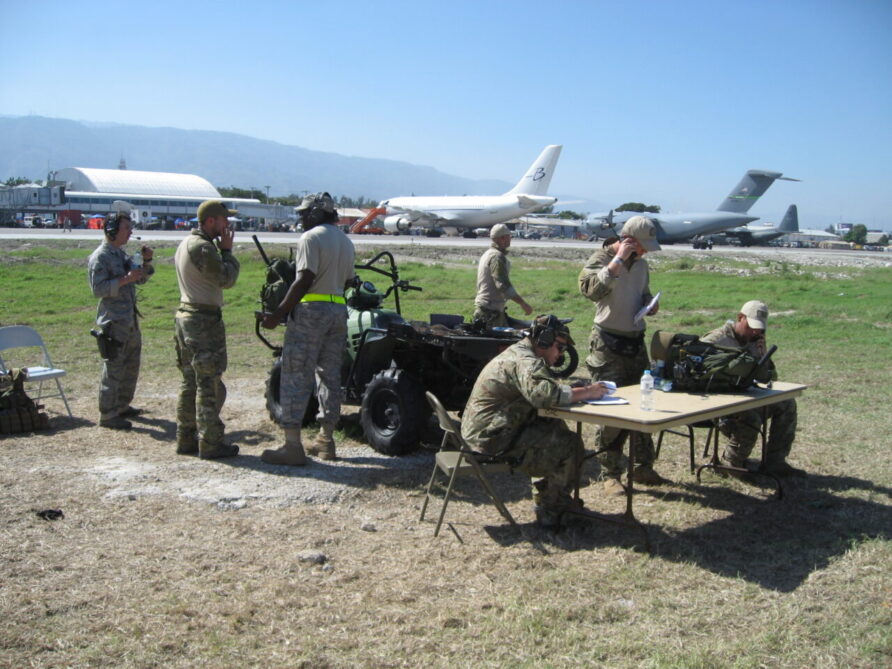
To illustrate the problems, this describes perfectly the situation.
Around midnight, a Chinese Airbus A330 landed and taxied into the parking ramp. The crew didn’t understand the instructions from the CCT controllers and shut down their aircraft in a position that blocked much of the parking ramp. Senior Master Sgt. David Baldridge, Wasilausky’s NCOIC, immediately recognized the problem.
The jumbo jet had a large number of passengers, all dressed in orange jumpsuits, and an even larger amount of cargo. There was no cargo door or handling equipment that could off-load the aircraft, and the Chinese said they wouldn’t leave without off-loading everything.
The people available, mostly Chinese urban rescue personnel, formed a “bucket-brigade” line to hand boxes down the crew-entrance ladder. After a couple of hours in the line, Baldridge went after what would be needed next. He got one of the Chinese crewmembers and went looking for a way to push the A330 backward when the time came for it to leave.
He found a tug big enough to tow the aircraft, and his Chinese assistant picked out a tow-bar. They returned and hooked it up. Just before 8:00 a.m., they pushed the jumbo aircraft back so it could start engines and taxi out. The jet had blocked almost half the parking ramp for eight hours.
By now, the airport passenger concourses had filled with news media filming and broadcasting “breaking news” of the efforts to get the aircraft out of the way.
By the time the Chinese aircraft had departed, there were four-hour waits to land, with many more in the hour.
Relief Web released an update on the 15th
Port-au-Prince Toussaint L’Ouverture International Airport (MTPP)
Haitian airspace is only open to humanitarian aircraft operating to and from Haiti’s airports. No possibility of any over-flights due to very limited staffing.
The ground stop that was issued by the Haitian Government at 15:00h GMT has been extended now through 19:00h GMT at the request of the Haitian government. Numerous aircraft are currently holding for a spot on the ramp at the airport, some for over two hours.
Some flights have been diverted to the Dominican Republic and Turks and Caicos Islands.
There is no fuel available at MTPP.
Once (if) the ground stop is released, aircraft filed for MTPP should plan at least one hour of holding fuel and enough extra fuel to get to a secondary airport after departing MTPP without refuelling.
The ILS, VOR, DME and runway lights are all reported as in service and working at this time.
The operators of aircraft going to Haiti are increasing their crew members to assist with off-loading due to equipment being very limited regarding the demands of aircraft on the ground.
The US Federal Aviation Authority (FAA) is setting up a Control Centre in Miami to manage the air traffic between the USA and Haiti.
At 15:00 on the 15th of January 2010, the Government of Haiti relinquished airspace control to the US 601st Air and Space Operations Center/Air Mobility Division (AOC/AMD) Regional Air Movement Control Center (RAMCC) for 72 hours (as described above), although this would be extended.
Helicopters also started to use the airport, evacuating wounded and other passengers.
Additional planners arrived to coordinate possible air drops of emergency supplies, by then in planning.
A management centre was established at Tyndall Air Base in Florida called the Haiti Flight Operations Control Center (HFOCC) to ensure the only aircraft with landing slots entered Haitian airspace. Evacuating civilian personnel, securing the airport and establishing expeditionary life support for deployed personnel were priority tasks.
The first large forklift arrived on the third AFSOC MC-130, with another on the way, fortunately, as the first broke down shortly after.
An advanced party from 82nd Airborne arrived on the 15th of January.
An article from NPR revealed a difference of opinion
Despite the progress, members of the Air Force team — the 621st Contingency Response Wing, one of two Air Force units specifically designed to open distressed airstrips — expressed frustration that they had not been sent earlier to manage the flow of aid into the airport, saying Thursday’s flight freeze may have been avoided.
“We would have liked to have been there a little bit sooner to unclog the airfield,” said Col. Brian O’Connor, the wing’s commander. “It makes me cringe, it’s so disorderly.”
Air-traffic control at the airport was taken over by an Air Force Special Operations team just hours after the quake, but the small group became overwhelmed by the traffic, officers said.
“When we got here, there wasn’t an empty spot on the” tarmac, said Col. Hollrah, who arrived Thursday night. “No one was in control of anything.”
Before the earthquake, the airport handled 12–15 flights per day, and daylight operation only.
Three days later, it was operating at over 60 flights per day, 24×7, and this increased over the following days to a movement intensity almost equalling that of the Berlin Airlift, all from a single runway.
The runway did not have a parallel taxiway and the main ramp area had a single entry and exit point, creating challenges for free-flowing traffic.
The ramp only had parking locations for 2 large aircraft and 6 smaller ones.
The HFOCC operated with the Government of Haiti, the World Food Programme and the United Nations to ensure the correct balance between cargo and personnel aircraft.
After the initial telephone access system to HFOCC started to show the strain, a web-based system was quickly implemented, improving matters considerably, particularly in transparency issues to ensure no accusations of priority could be levelled.
There were complaints that military flights were being prioritised, and the usual media commentators with zero understanding of air logistics took to the air to criticise the USAF.
It was all completely unwarranted.
Helicopters from the USS Carl Vinson started to use the airport.
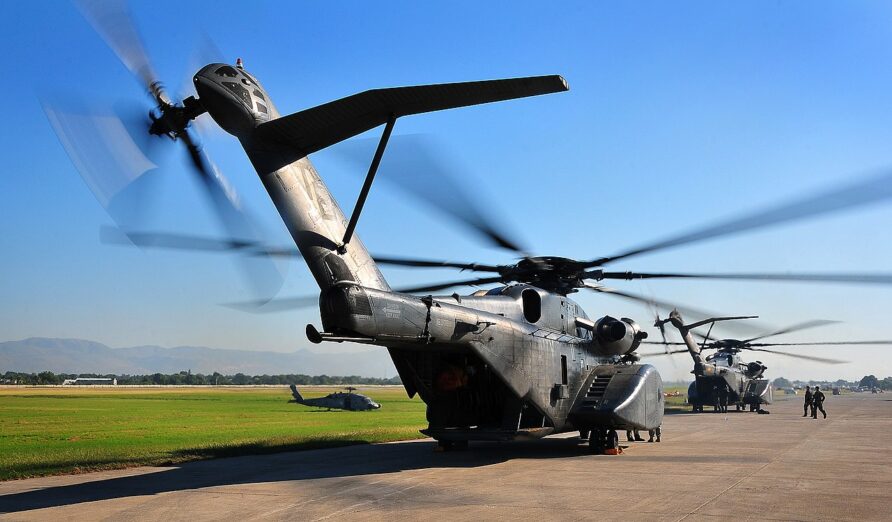
Three C-17s with a Deployable Joint Command Centre arrived.
It wasn’t just military flights.
The DHL DRT Americas started operating out of Toussaint L’Ouverture International Airport in Port-au-Prince within 48 hours. The team, made up of 10 DHL volunteers, was the first logistics team at the airport and handled 500 tonnes of relief goods within the first week.
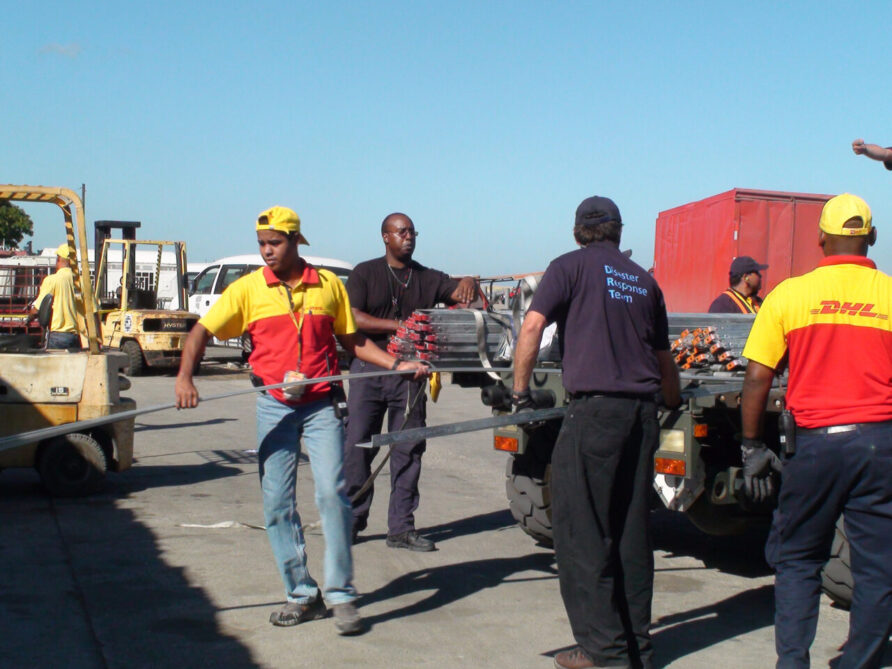
U.S. military helicopters airlifted 27,000 Humanitarian Daily Rations (HDRs) from Guantánamo Bay to Port-au-Prince for consignment to WFP on January 16th.
Three USAID/OFDA water treatment units arrived in Haiti on DoD C-130 aircraft, each capable of generating 100k litres of potable water.
An EC-130J Commando Solo aircraft began transmitting on the 15th of January.
Free-form radio it ain’t: According to CNN, Commando Solo is relaying live broadcasts of Voice of America call-in shows in Creole, Haiti’s national language. During breaks in the live programming, the plane broadcasts pre-recorded public service announcements. Some of those spots are practical advice — information on emergency sanitation, for example — but there is also some propaganda: Pre-recorded warnings discourage Haitians from trying to attempt a dangerous ocean crossing to Florida.
A seven-man team from the FAA arrived to support airport authorities and the USAF teams on site, with a view to re-establishing civilian control.
By the 15th, nine helicopter landing sites were being used, and one for airdrop, although USAID recommended stopping these until improved coordination could be established.
82nd Airborne were lifted to Landing Zone 6 ‘Golf Course’ and secured it.
By the 17th of January 2010, six hundred flights had transited through the airport.
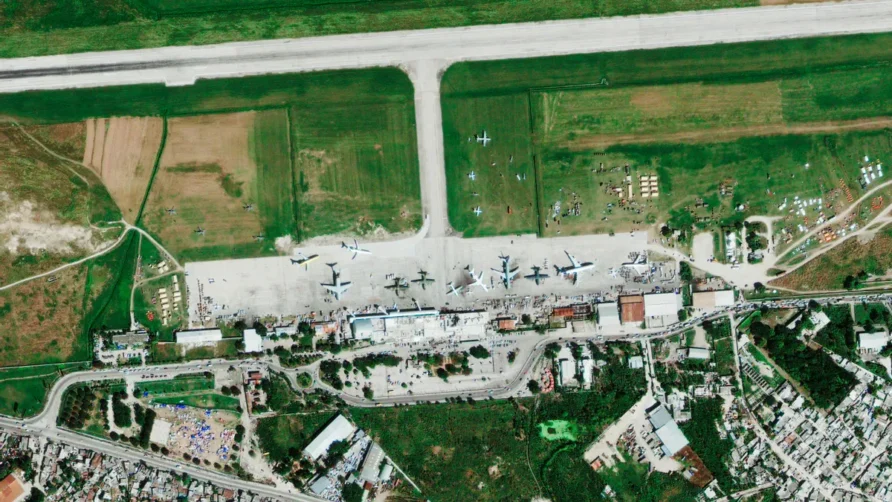
The FAA team and Haitian air traffic controllers had now re-established airspace control with the USAF teams guiding them in at low level and whilst on the ground. The landing lights were fully working.
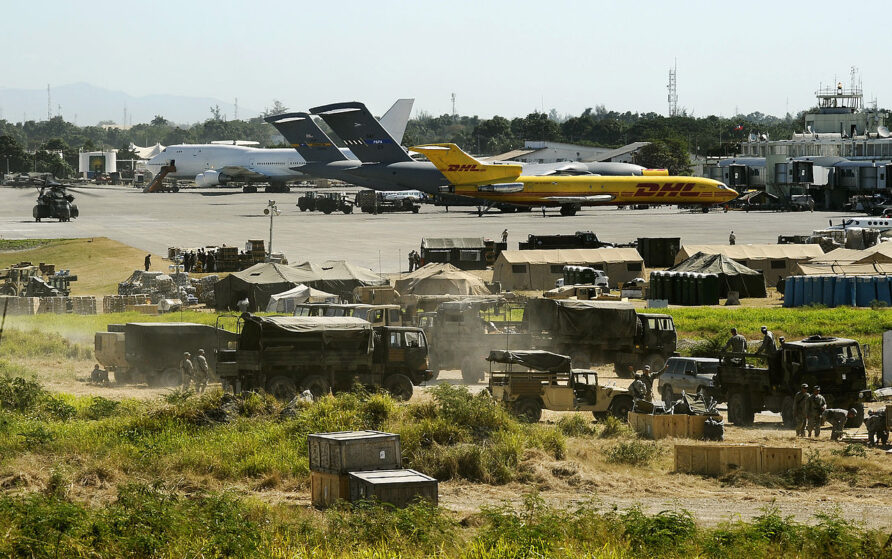
A large airdrop was conducted on the 18th, with three C-17s operating from Pope AFB.
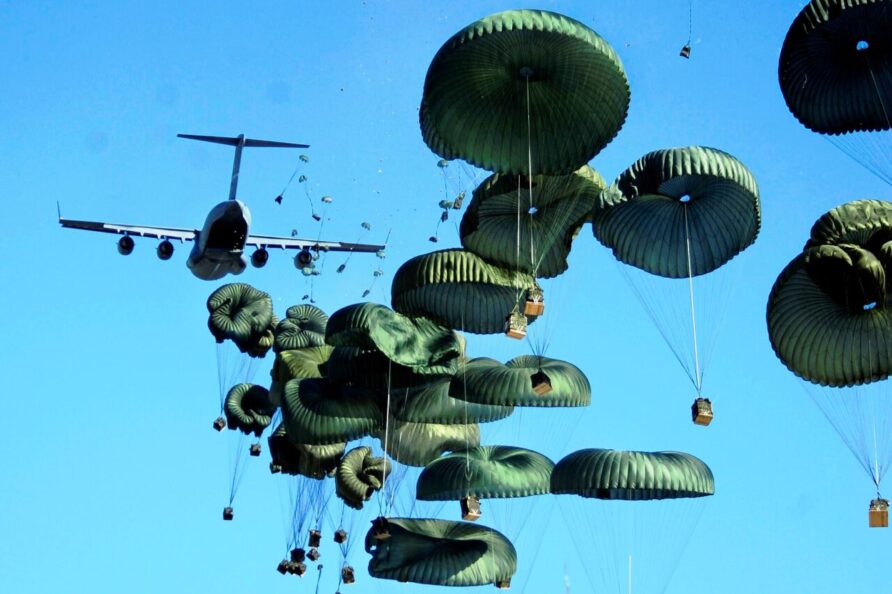
The combat controllers were also surveying landing sites outside of Port-au-Prince.
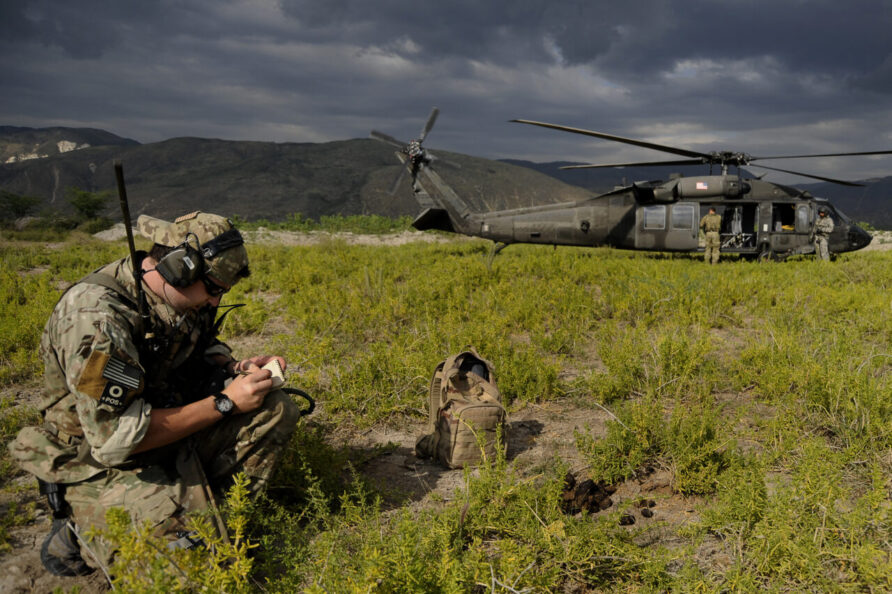
The target for full hand back to civilian authorities was the 25th of January 2010.
The lack of cargo and aircraft handling equipment meant that it was only operating at 40 % of its capacity, despite record numbers of aircraft movements.
14,098 tonnes of supplies were offloaded and 15,495 passengers were loaded by the time the airport was handed fully back to civilian control.
The HFOCC coordinated 3,940 international flights.
On the 19th of February 2010, civilian control of the airport was returned.
Think Defence is a hobby, a serious hobby, but a hobby nonetheless.
I want to avoid charging for content, but hosting fees, software subscriptions and other services add up, so to help me keep the show on the road, I ask that you support the site in any way you can. It is hugely appreciated.
Advertising
You might see Google adverts depending on where you are on the site, please click one if it interests you. I know they can be annoying, but they are the one thing that returns the most.
Make a Donation
Donations can be made at a third-party site called Ko_fi.

Think Defence Merch
Everything from a Brimstone sticker to a Bailey Bridge duvet cover, pop over to the Think Defence Merchandise Store at Red Bubble.
Some might be marked as ‘mature content’ because it is a firearm!
Affiliate Links
Amazon and the occasional product link might appear in the content, you know the drill, I get a small cut if you go on to make a purchase
The Air Traffic Control Tower
The control tower was beyond repair and so for most of the initial phase, air control duties were performed from open-air locations.
When the FAA team arrived on the 15th of January, one of their priorities was replacing the tower.
On January 22nd, 2010, a Russian AN-124 transport aircraft was loaded at Homestead Air Reserve Base in Florida with a deployable ATC trailer.
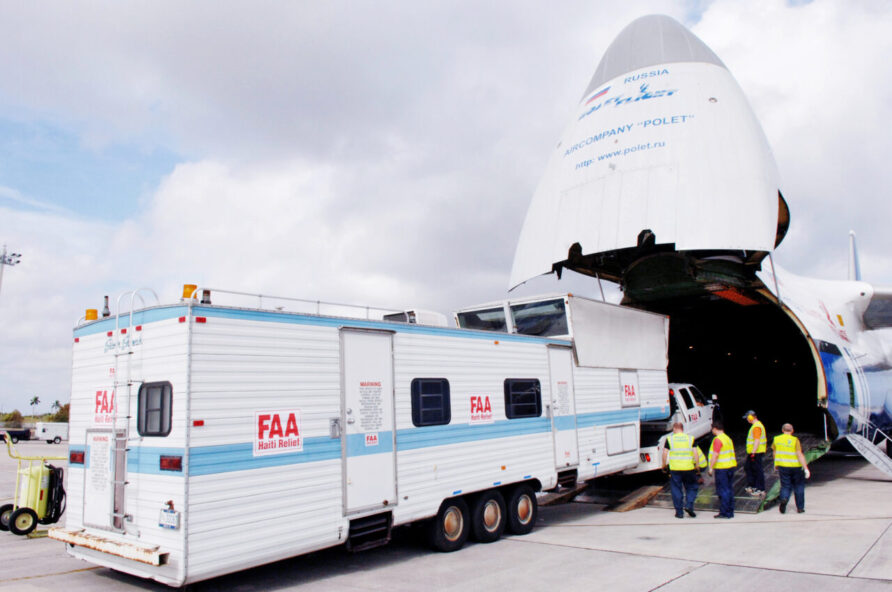
The USAF reported.
The government of Haiti asked the U.S. government to help with a solution. In response, the FAA produced a mobile control tower used for relief efforts following Hurricane Katrina in 2005, said Angus Wall, the FAA Miami Technical Support Center manager.
The 44-foot mobile facility features a design similar to a fifth-wheel trailer that can be towed by a truck. Standing 13 feet high and 8 feet (2.44 m) wide, it contains all the equipment necessary to fully coordinate the international inflow of relief workers and supplies, Mr. Wall said.
“By installing this air traffic control tower, not only do we give controllers a place to operate, but we establish communications with these other air traffic organizations,” he said. “So we can coordinate planes taking off from everywhere from Juneau, Alaska, to Madrid, Spain, to Russia, to England.”
With improved communications, aircraft will flow in and out much more efficiently, he added.
Only one challenge remained: delivering the tower to Haiti. Mr. Wall said the mobile tower has never been outside the United States.
U.S. Southern Command officials coordinated for the FAA equipment and the aircraft to use Homestead Air Reserve Base, Fla., as the loading point.
Because of the timing involved, the Air Force contracted the Voronezh, Russia-based Polet Airlines Cargo charter services, to move the equipment.
The Antonov An-124 from Polet Airlines, the world’s largest cargo aircraft, arrived at Homestead ARB, Jan. 21. More than 100 Airmen helped position the equipment on the flightline and assisted the Russian crew as they loaded the aircraft.
Mikhail Trapeznikov, the An-124 flight manager and radio operator, said he and his team are proud to be a part of this mission.
“We’ve done a lot of (humanitarian) missions,” Mr. Trapeznikov said. “It’s nice to be a part of it.”
In addition to the Air Force and Polet Airlines, other organizations such as the Federal Emergency Management Agency, the U.S. Agency for International Development and the FBI also contributed to the effort, Mr. Wall said.
The mobile air traffic control tower will take approximately 48 hours to become fully operational and an FAA technical support team will remain with the tower until it’s no longer needed.
Upon arrival, the trailer was loaded and working within two days.
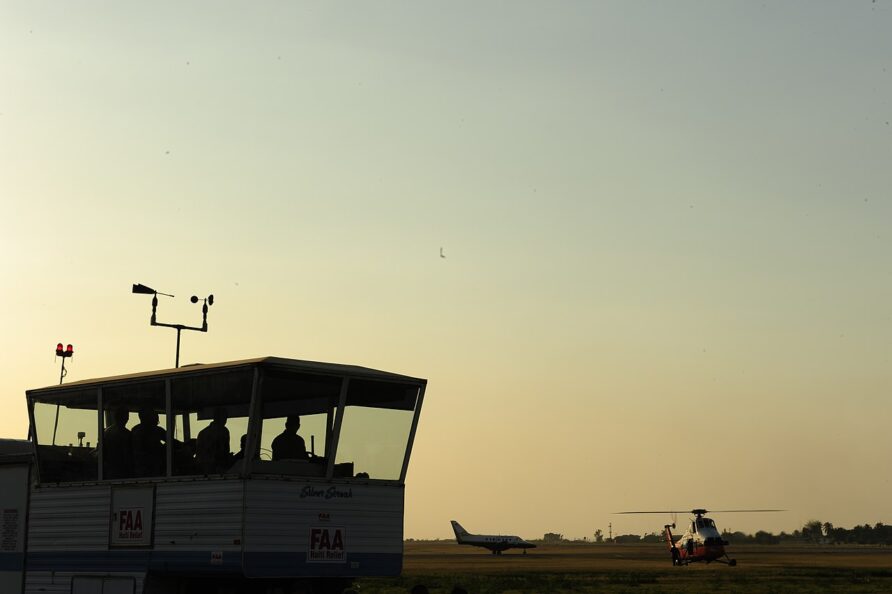
Jacmel
Although the focus was on Port-au-Prince, additional capacity was established at airports in the Dominican Republic and a Canadian team opened the 1,000m Jacmel airstrip in southern Haiti to provide an invaluable divert location for smaller aircraft.
Personnel from 2 Air Movements Squadron, 8 Air Communications and Control Squadron and 8 Air Maintenance Squadron contributed to the air component of Operation HESTIA.
The image below shows Captain Suzan Carignan and Captain Rod Zeaton controlling air traffic in the improvised tower at Jacmel Airport.
Trees at the runway edge meant that only C-130s could access the runway, but after work from combat engineers, the first C-17 landed on the 20th of February.
Lighting and other enhancements expanded the capacity of the airfield considerably, up to approximately 160 aircraft movements per day at the peak.
The rest of the series
- Introduction
- Over the Shore Logistics in and around Port International de Port-au-Prince
- Air Operations and Toussaint L’Ouverture International Airport
- Observations
Read more (Affiliate link)





